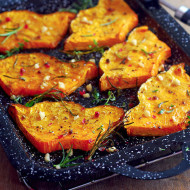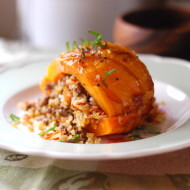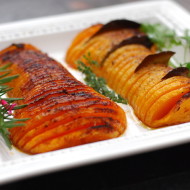Encyclopedia of useful foods or how to grow Butternut pumpkin in the beds
Content
Description of Butternut pumpkin
Butternut pumpkin is an interspecific hybrid of butternut squash and bottle-shaped African fruit. North America is called the birthplace of culture. It is massively grown in Mexico and other countries with warm climates. Despite the harsh and sometimes unstable climate of Russia, the plant quickly adapted to our realities. It can be grown both on private agricultural land and on an industrial scale.
Its name - Butternut - the fruit culture received from the English word butternut, which literally means "butter nut". The etymology of the name is related to the taste characteristics of the fruit. Butternut pumpkin has a nutty aroma and nutty flavor. For this reason, Butternut is often referred to as butternut squash.
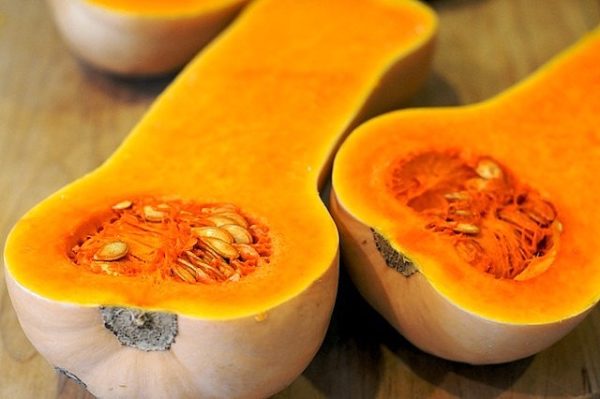
There are two types of Butternut pumpkin: bush (Bush Butternut) and climbing (Waltham Butternut). The main difference is the appearance of the plant. From the names themselves, it becomes clear that a bushy culture is formed in the form of a bush with a diameter of up to 1.5 m, and a climbing one has branched shoots up to 2.5 m long.
It grows both on the ground and on trellises. Since the fruits are small in size and low in specific gravity (about 1–1.5 kg), the branches do not fall off the supports. This variety is characterized by large leaf plates of a rich green hue. The leaf shape is standard for members of the Pumpkin family.
The fruits are pear-shaped, elongated. The color of the peel is light orange. But the flesh of the fruit has a beautiful juicy orange hue. The rind is thin but very firm. The seed part is located in the lower (expanded) part of the fruit.
Productivity and ripening time
Butternut belongs to early maturing garden crops. With a favorable microclimate and the accompanying high yield of weather conditions, the first fruits can be removed already 3 months after the formation of ovaries on climbing shoots.
The average yield per bush is 12-15 kg. In the southern regions, yields can reach 20 kg per plant. If the gardener was engaged in the formation of lashes for growing large-fruited pumpkins (4-5 kg each), then only a few ripe fruits are removed from one bush.
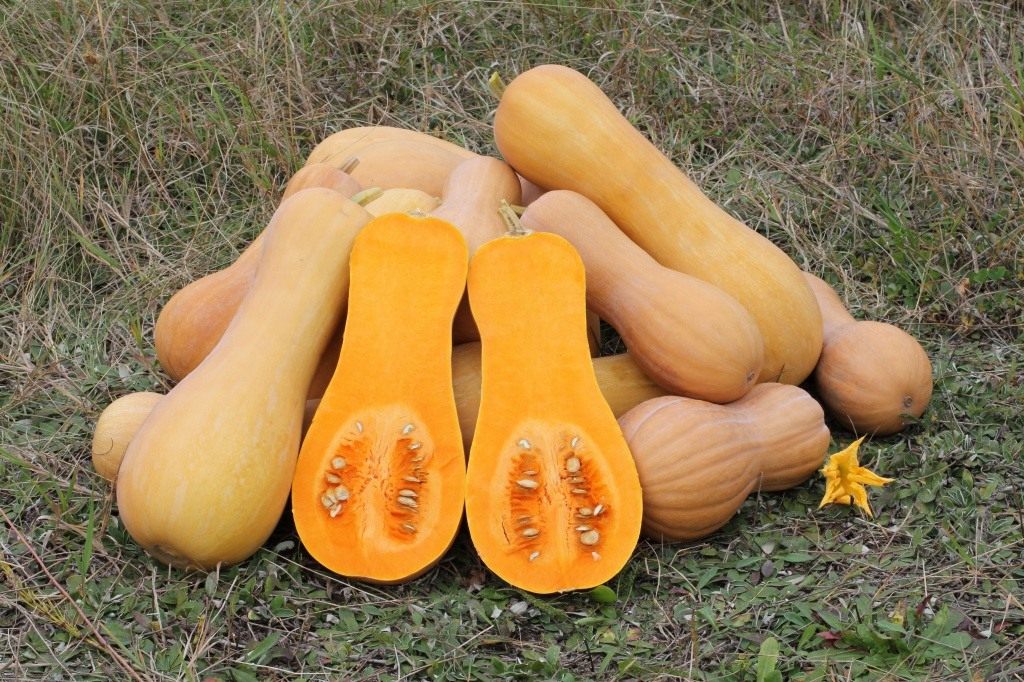
Fruit taste and aroma
Pumpkins that have reached technical maturity are distinguished by a pleasant aroma and interesting taste - buttery-nutty. As you can see, the garden culture fully justifies its name.
- early fruiting;
- high productivity;
- unpretentiousness to care;
- excellent consumer qualities and universal use of fruits;
- long storage period of the harvested crop;
- a small amount of seeds.
- exactingness to the soil composition;
- difficulties with pollination;
- loss of taste and marketability when infected with fungal or bacterial infections.
Video "All About Butternut Pumpkin"
This video describes the fruits of the culture, and also tells about the features of the use and storage of the product.
Agrotechnics of pumpkin varieties Butternut
As you know, the yield of cultivated plants grown in the beds depends not only on weather conditions, but also on a person. Today we will tell you how to plant and grow Butternut pumpkin outdoors.
Seat selection
The optimal place for growing pumpkins is beds protected from wind and drafts. In this case, the plot of the garden should be well lit by the sun. The plant does not like wetlands, acidic and alkaline soil. The best soil option is loam with the addition of dolomite flour.
Seed preparation and sowing
Seeds selected for sowing are soaked in a growth biostimulator, spread on a damp cloth and allowed to germinate. After 25-30 days, the seeds can be planted outdoors.
Sowing of planting material falls on the last decade of May or early June. When forming the beds / holes, maintain a distance of 60 to 70 cm. The seed is planted in such a way that the hatched sprout "looks" up.
Watering and mulching
Butternut loves abundant watering, but at the same time suffers from excess moisture in the soil. The frequency of watering should be determined by the degree of soil drying and the amount of precipitation. Watering the beds is stopped 2–2.5 weeks before harvesting.
Do not neglect the mulching procedure. In this way, the growth of weeds can be prevented and the nutritional properties of the soil can be preserved. Hay, straw or dry vegetation are used as mulch.
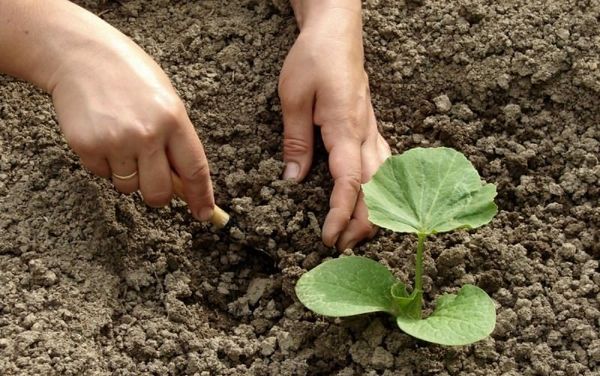
Plant feeding
Beds with fruit crops are fed with mineral fertilizers. During the period of active growth and development, nitrogen-containing preparations are introduced. At the stages of flowering and fruiting, potash and phosphorus fertilizers are added. In one season, pumpkin is fed at least 2-4 times.
According to the reviews of experienced gardeners, organic matter can be used to feed Butternat. Wood ash, bird droppings diluted with water (1:20) or rotted manure (1:10) are suitable.
Pollination of culture
To pollinate the pumpkin grown in the garden, insects, in particular bees, are attracted. If the weather is cloudy and damp, you can pollinate the plants yourself. In the first half of the day, when the inflorescences are open, the "male" flowers are applied to the "female" ones.
Bush formation
The formation of a culture helps to improve fruit production. No more than 2 healthy and well-developed shoots are left on one bush. But the number of ovaries can be determined at your discretion. When the first fruits appear, you need to tear off the excess leaves.
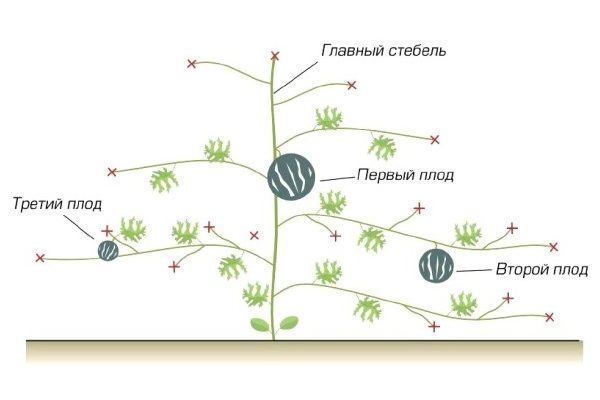
Diseases and pests
With improper care, the plant suffers from fungal and bacterial infections, which negatively affects the taste and marketability of the fruit. In addition, the pumpkin is often besieged by spider mites and aphids.
Butternut is not recommended to be treated with chemicals. To combat insects and diseases, folk methods are used - soap solution, garlic water, diluted Bordeaux liquid, etc.
Useful properties of pumpkin
Nutritional value of Butternut pumpkin is 45 kcal. 100 g of ripe product accounts for 9.69 g of carbohydrates, 1 g of protein and 0.1 g of fat. Juicy and aromatic fruits contain a huge amount of vitamins and minerals.So, the chemical composition of the product includes vitamins C, E, K, PP and group B. Pumpkin is rich in potassium, magnesium, sodium, phosphorus, iron, manganese, calcium, copper, selenium, zinc and other nutritious micro- and macronutrients.

Thanks to such a rich chemical composition, culture has a beneficial effect on humans. With regular use of pumpkin, there is an improvement in the functioning of the digestive, cardiovascular and nervous systems. Also, the product helps to strengthen the nail plates and hair follicles.
Butternut has some contraindications. The product is contraindicated in case of individual intolerance, tendency to allergies and high acidity. The use of buttery-nut pumpkin is not recommended for diabetes mellitus.
The use of Butternut in cooking
Butternut squash is one of the few pumpkin family foods that can be eaten raw. The recipe for a vitamin salad based on pumpkin (300 g), apples (200 g) and liquid lime or acacia honey (100 ml) is popular among hostesses.
Butternut retains most of its nutritional and beneficial properties when cooked. Therefore, the product can be used to prepare casseroles, first courses, side dishes and warm appetizers. Don't forget about the beneficial and healing properties of nutritious pumpkin juice.
Pumpkin Butternut is famous for its high yield and unpretentious care. Even a novice gardener can handle the cultivation of this fruit crop.

